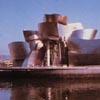
|
Established over sixty years ago by philanthropist Solomon R. Guggenheim and artist-advisor Hilla Rebay, the Guggenheim Museum has consistently exhibited cutting-edge art, initially making a commitment to the modernism of the twentieth century. In 1959, the museum opened its first permanent building on Fifth Avenue in New York, a design by American architect Frank Lloyd Wright. In contrast to the rigorous rectilinear grid of the city and its buildings, the Guggenheim was composed of a continuous curve, creating on the interior a fascinating cyclical ramp. This rotunda is considered one of the great buildings of the century. In 1997, as part of a multi-year expansion of the museum's holdings and locations, the Guggenheim built new exhibition space in Bilbao, in the Basque region of Spain. Designed by Frank Gehry, the building's unusual curves represent disjunctures and ruptures that counter the gracefulness of the Wright building and reflect the less confident cultural era of postmodernism. Guggenheim Bilbao's billowing forms and shimmering titanium tiles could only have been designed with the assistance of computer programming. The building joins other planning efforts in the city by important contemporary architects such as Santiago Calatrava and Norman Foster in an initiative to revitalize the economy of the Basque region. |
GUGGENHEIM BILBAO RESOURCES
|